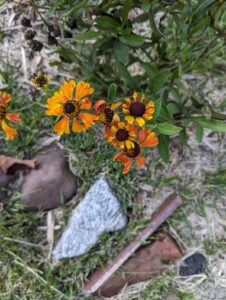 The name ‘sneezeweed” seems akin to “ragweed” and immediately conjures up visions of runny noses, watery eyes and seasonal misery. Most people would not deliberately plant something with that kind of unsavory reputation.
The name ‘sneezeweed” seems akin to “ragweed” and immediately conjures up visions of runny noses, watery eyes and seasonal misery. Most people would not deliberately plant something with that kind of unsavory reputation.
There is nothing to be done about horticultural guilt by association. It is reassuring to know that “sneezeweed” does not have ragweed’s allergenic qualities, though both species belong to the daisy or Compositae family and appear at the same time in the late summer or early fall.
Perennial sneezeweed, known more poetically as “Helen’s flower” and botanically as helenium, is better looking than ragweed and is renowned for its beauty in the late-season garden. The daisy-like flowers bloom in rich fall colors—golds, oranges and russets—surrounding plump, brown central cones. In the annual succession of daisy family plants, they come well after the high summer daisies, like coneflowers and Shastas, and about the same time as the asters, boltonias and early mums. Generally they finish their run before the Montauk daisies reach their peak.
So why call the species “sneezeweed” when the plants don’t make most people sneeze? Because sometime, probably in the distant past, people who may not have had access to traditional snuff, dried and ground the leaves of the plant, and—presumably—stuffed the mixture up their noses to achieve a pleasant effect or, as the Lady Bird Johnson Wildflower Center’s article suggests, felt that the snuff would rid the user of evil spirits.
I rid myself of evil spirits by going out in the garden, so I have no need of a helenium-powered inhalant to do the job. I can appreciate my helenium plant, acquired last year after about a decade of coveting the species, by gazing at the flowers, or cutting stems to use in fall arrangements.
My helenium is a specimen of the most popular variety, ‘Moerheim Beauty’, a hybrid of Helenium autumnale, which is native to the northern half of the United States and parts of Canada. The species grows between two and five feet, with leaves shaped like elongated ovals and a branching habit. The flowers are yellow, with downward pointing toothed petals that are somewhat fan-shaped. The central cones are prominent, very much like those of coneflowers.
‘Moerheim Beauty’, features the same flower configuration, but with a flashier color profile. Each petal is golden with an orange overlay, so that the gold seems to outline the orange. The petal edges feature three scallops apiece. The plants are smaller than those of the species, Helenium autumnale, reaching a manageable two to three feet tall, with a maximum spread of 1.5 feet. If you do the “Chelsea chop” in late May, the plants will be a bit shorter and more floriferous due to increased branching.
The good news is that you can choose to do the “Chelsea chop” with your clippers, rather than worrying that the local deer will do the job for you in an unsatisfactory way. A hungry deer will probably eat barbed wire, but in the normal course of events deer tend to shy away from helenium.
You won’t have to do the chop with ‘Balsaluemb’, sold under the trade name Salud Embers. It features the same color scheme as ‘Moerheim Beauty’, but only grows 18 inches tall and wide. This may be a good choice for smaller gardens or containers.
Another hybrid, ‘Dancing Flames’ is about the same size as ‘Moerheim Beauty’, but with petals that open flame-red and then age to golden yellow.
Last year, my helenium, planted appropriately in a sunny spot, languished a bit because the weather was dry. This summer, with an abundance of rain, it thrived. Sun, consistent moisture and little or no fertilizer produce healthy, floriferous plants. Happy plants form clumps that can be divided after a few years.
By many accounts the great plant taxonomist Linnaeus, a good classical scholar, like most scientists of his time, christened helenium in honor of the mythical beauty, Helen of Troy. Whatever the derivation of the name, it more inspiring to think of a beautiful literary heroine than snuff-induced sneezes.
Find an excellent selection of helenium at Digging Dog Nursery, 31101 Middle Ridge Road, Albion, CA 95410; (707) 937-1130; www.diggingdog.com. Print catalog available.
